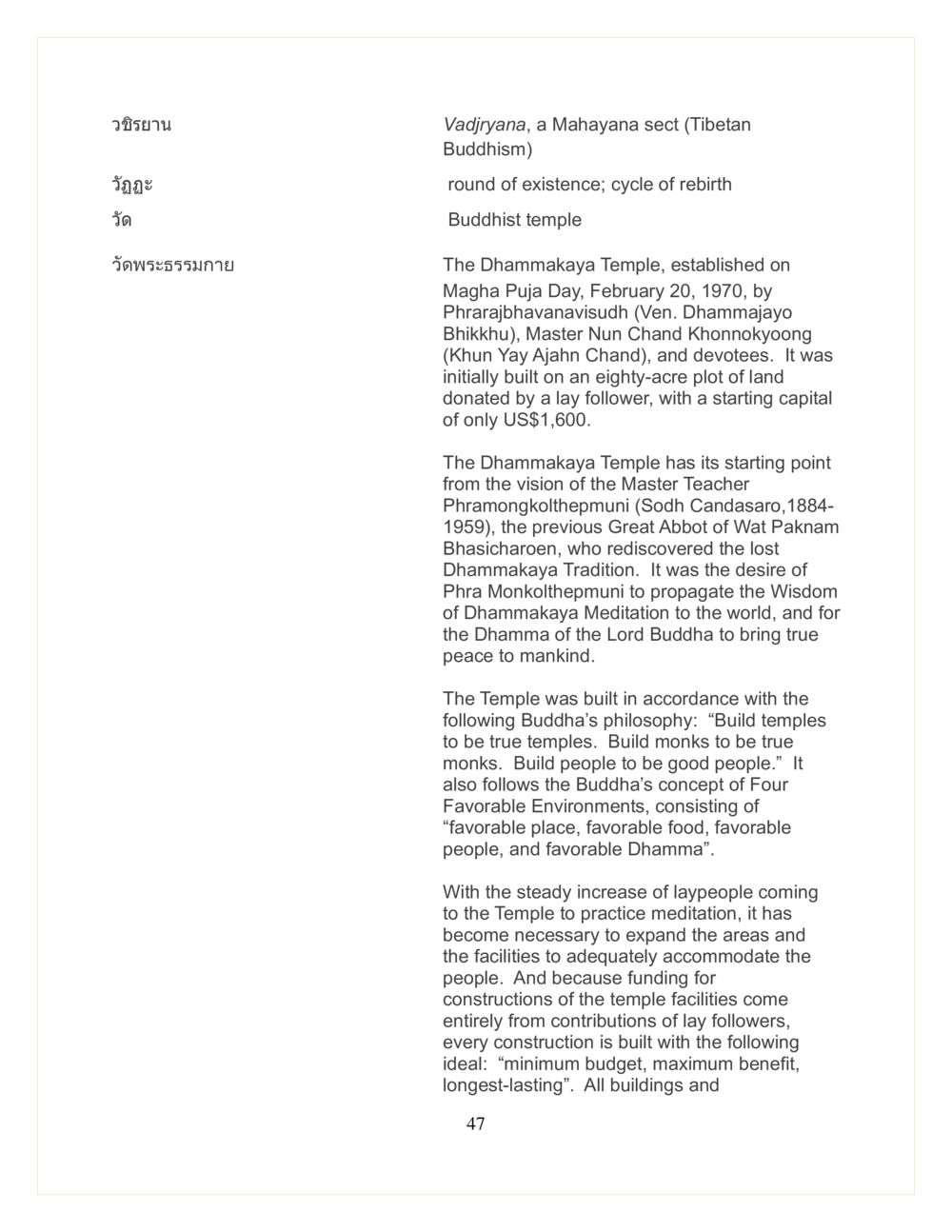วัดพระธรรมกาย: อาณาจักรแห่งการฝึกสมาธิในพระพุทธศาสนา : หน้า 47/115
DMC Translor’s handbook : หน้า 47/115 การสำรวจวัดพระธรรมกายและแนวทางการฝึกสมาธิในพระพุทธศาสนาเพื่อความสงบและปัญญา
16 ครั้ง

สรุปเนื้อหา
วัดพระธรรมกายถูกก่อตั้งในวันมหาปุญญาเมื่อ 20 กุมภาพันธ์ 1970 โดยกลุ่มพระธรรมและผู้เลื่อมใส เจ้าอาวาสพระมงคลเทพมุนีได้เผยแพร่การทำสมาธิธรรมกายเป็นวิธีการเพื่อเสริมสร้างความสงบและปัญญาแก่ผู้คน วัดดำเนินการโดยอิงตามปรัชญาพระพุทธเจ้าในการสร้างวัดและการพัฒนาคนให้ดี นอกจากนี้ยังมีการขยายพื้นที่และสิ่งอำนวยความสะดวกเพื่อรองรับจำนวนผู้ที่มาใช้บริการอย่างต่อเนื่อง ด้วยแนวทางการก่อสร้างที่เน้นการใช้งบประมาณต่ำสุดและประโยชน์สูงสุด โดยทุกส่วนของวัดเป็นไปเพื่อช่วยเหลือทุกคนที่ต้องการค้นคว้าและเข้าถึงความรู้ธรรมะในชีวิตประจำวัน.
หัวข้อประเด็น
-วัดพระธรรมกาย
-การฝึกสมาธิ
-พระพุทธศาสนา
-การก่อสร้างวัด
-วิทยานิพนธ์ทางธรรม
-พุทธศาสนิกชน
ข้อความต้นฉบับในหน้า
วชิราน
Vadjrayana, a Mahayana sect (Tibetan Buddhism)
่วัฏจะ round of existence; cycle of rebirth
วัด Buddhist temple
วัดพระธรรมกาย The Dhammakaya Temple, established on Magha Puja Day, February 20, 1970, by Phrarajbhanavisudh (Ven. Dhammajayo Bhikkhu), Master Nun Chand Khonnokyoyng (Khun Yai Ajahn Chand), and devotees. It was initially built on an eighty-acre plot of land donated by a lay follower, with a starting capital of only US$1,600.
The Dhammakaya Temple has its starting point from the vision of the Master Teacher Phramongkolthepmuni (Sodh Candasaro, 1884-1959), the previous Great Abbot of Wat Paknam Bhasicharoen, who rediscovered the lost Dhammakaya Tradition. It was the desire of Phra Monkothepmuni to propagate the Wisdom of Dhammakaya Meditation to the world, and for the Dhamma of the Lord Buddha to bring true peace to mankind.
The Temple was built in accordance with the following Buddha’s philosophy: “Build temples to be true temples. Build monks to be true monks. Build people to be good people.” It also follows the Buddha’s concept of Four Favorable Environments, consisting of “favorable place, favorable food, favorable people, and favorable Dhamma”.
With the steady increase of laypeople coming to the Temple to practice meditation, it has become necessary to expand the areas and the facilities to adequately accommodate the people. And because funding for constructions of the temple facilities come entirely from contributions of lay followers, every construction is built with the following ideal: “minimum budget, maximum benefit, longest-lasting”. All buildings and
หน้าหนังสือทั้งหมด
หนังสือที่เกี่ยวข้อง
Load More



















































































































